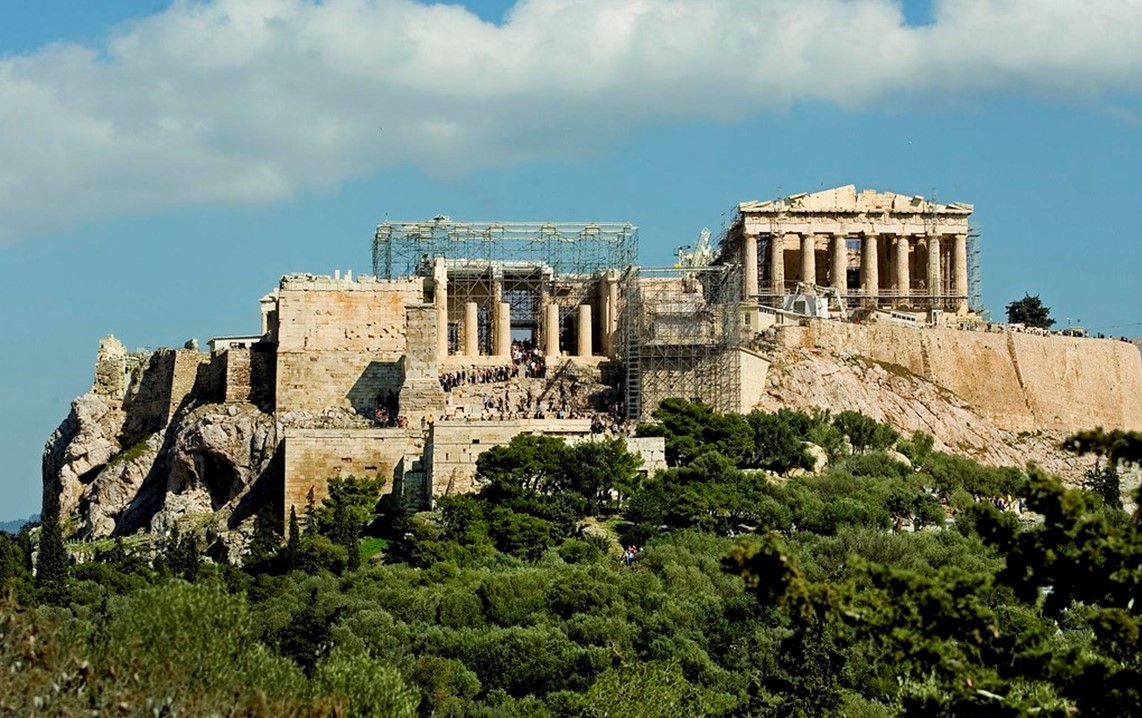ATHENS
THE CRADLE OF CIVILIZATION!
Athens, the capital of Greece since 1834, is located in the foreground of the events, as it is the economic and cultural center of the country.
It is surrounded by 4 mountains, whereas its 5th side expands in the Saronic Gulf, part of the Aegon sea. In the heart of the city, a total of 7 hills stand out, with the highest among them being the hill of Lycabettus. However, the most famous is the hill of the Acropolis. Around the Acropolis Hill, the whole history of Athens unfolds, and with the years passing, its fame became known to the whole ancient world. The name of the city of Athens stems from its protector, goddess Athena. One more clue as evidence for the ancient roots of the city. Its initial name was Athenae and in the middle ages it was officially changed to Athina or Athens, after the establishment of the modern Greek language.
THE GREAT HISTORICAL CITY
Its great story goes back to 3000B.C. with the classical period being the peak, as it depicts the development of the city, as well as the Persian Wars, and the conflicts among Greek cities themselves, like Sparta, Corinth, Thebes and many others. The 5th century B.C. is a major historical station, as it brought many social, economic and cultural changes, which influenced the world to the better. The establishment of Democracy in the Ancient Agora and the justification of Areios Pagos or Mars Hill are of special importance. The ancient theater and arts like sculpture played a significant role, and, as a result, even today’s whole world is taught the Athenian lifestyle of that era. Classical monuments with the most famous being the unique monument of the western civilization, the Parthenon, established the fame of Athens as a supreme power and dominant city of the ancient world.
With the rise of the Macedonian Empire of Alexander the Great, the city is in the epicenter of the events, with its style remaining alive, without being as influential as it was, while the picture of the city is distorted with the entrance of the Roman Empire in Greece. The Romans respected the history of Athens, and this is proven due to the fact that they expanded and reconstructed it during the Roman times, leaving a big number of monuments, which have survived until today, as heritance. A significant historical station for the Athenian philosophers and citizens is the passing of Apostle Paul to Athens, right before he went to Corinth.
Christianism became the official religion in Greece and the religion to the Twelve Olympians was abolished after the Byzantine Empire gathered power. Athens becomes a point of reference in Christian and Byzantine monuments, resulting to the Athenians’ strong faith. With the fall of the Byzantine Empire, the bloodshed years of the Ottoman occupation affected the life in Athens in an enormous degree. The picture we get from Athens during the occupation is like a big village with poor development. Four hundred years had to pass in order for Athens to gain its pride, and a few years after the Greek Revolution, it was established as the official capital of modern Greece. The changes go by one after the other. Political, cultural and artistic changes reform its picture and it becomes again the epicenter of the country. The power keeps altering between the king and the government, and the dimension of Athens expands with a rapid pace for once more. It becomes a commercial center of the Mediterranean Sea and one of the biggest in Europe, which does not go by unnoticed by the European powers of the era.
During the 2nd World War, the city was occupied by the Germans. In the last few years of the war the residents suffered a lot and the city sustained many damages. After the war, Athens starts developing again. Moreover, during the 60’s, many buildings were being erected in the city center and the suburbs. New neighborhoods are created and the city changes its form. The single houses give their place to blocks of flats.

BIG EUROPEAN AND OLYMPIC
With Greece entering the European Economic Community we have more investments, new work places, and in the meantime, traffic problems start occurring, which will be later on solved after about 20 years, with the reconstruction of the road network, the purchases of more technologically advanced vehicles, and the expansion of urban transportation. With the construction of the metro, we discover treasures which were buried under the earth for millenniums. Combined with whatever it shows from ancient times, it attracts visitors. The global interest for travelling promotes the city among the most preferred tourist destinations.
Athens is the first host of the Olympic Games (1896) of the modern era. In the more recent years, it also hosted the 2004 Olympic Games, sky-rising its popularity. The program of Athens to host the Olympic Games included the construction of new roadways, sport facilities, stadiums, and the construction of new of the new airport in Athens, which resulted in tourist development and decentralization. Moreover, the city spread to the to the eastern suburbs and more tourists came into the country. About 800 flights come into the airport of Athens daily, from every corner of the world.
THE CLIME OF ATHENS
The climate has all the characteristics of the Mediterranean climate of 4 seasons. During the summer, the temperature averages from 25-35 degrees Celsius, although some days are extremely hotter than others, and therefore forcing all of the citizens to go to the beach. During the winter, the temperature averages from 5-15 degrees Celsius with plenty of rains, and many times the residents decide to get a little loose with some snow, and visit some of the most famous winter destinations in the weekends. Humidity isn’t a rare occurrence, and sometimes the southern winds convey dust from Africa.
THE HIGHLIGHTS OF ATHENS
Now, travelers from all over the world desire a visit in Athens at least once in their lifetime, in order to “steal” some of the city’s glory. Visitors can’t have enough of the strolls in Plaka with its picturesque stone-built roads, the Ancient Agora, the Areios Pagos and of course the Acropolis Hill, on the peak of which great artistic structures where built, which the whole human existence has set as an example of representative samples of the Greek civilization. And this is only the beginning.
Picturesque neighborhoods in the Historical center of the city from which we have chosen and will elaborate on them are:
While driving in the coastal highway that surrounds the most municipalities of Athens, the view of the Saronic Gulf is breathtaking. The delta of Faliron, Glyfada, Vouliagmeni and Varkiza are always the most famous destinations in Athens for taking strolls, with many shops and entertainment centers, and many visitors crowd the beaches of Athens, enjoying the sun and the sea.
“MY GREECE TOURS” offers tailor-made Day Tours in Athens for everyone who is visiting this unique destination. Keep reading to find out more information on day tours in Athens.






